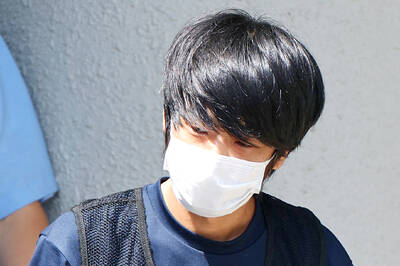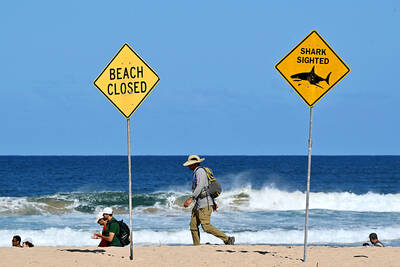In the world’s coldest capital, many burn coal and plastic just to survive temperatures as low as minus-40°C — but warmth comes at a price: Deadly pollution makes Ulaanbataar’s air too toxic for children to breathe, leaving parents little choice but to evacuate them to the countryside.
This exodus is a stark warning of the future for urban areas in much of Asia, where scenes of citizens in anti-pollution masks against a backdrop of brown skies are becoming routine, rather than apocalyptic.
Ulaanbaatar is one of the most polluted cities on the planet, alongside New Delhi, Dhaka, Kabul, and Beijing. It regularly exceeds WHO recommendations for air quality even as experts warn of disastrous consequences, particularly for children, including stunted development, chronic illness, and in some cases, death.

Photo: AFP
Erdene-Bat Naranchimeg had to watch helplessly as her daughter Amina battled illness virtually from birth, her immune system handicapped by the smog-choked air in Mongolia’s capital.
“We would constantly be in and out of the hospital,” Naranchimeg said, adding that her child contracted pneumonia twice at the age of two, requiring several rounds of antibiotics.
This is not a unique case in a city where winter temperatures plunge toward being uninhabitable, particularly in the districts that rural workers moved to in search of a better life.

Photo: AFP
Here row upon row of the traditional tents — known as gers — are warmed by coal, or any other flammable material available. The resulting thick black smoke shoots out in plumes, blanketing surrounding areas in a film of smog that makes visibility so poor it can be hard to see even a few meters ahead.
Hospitals are packed and young children are vulnerable; common colds can quickly escalate into life-threatening illness.
The situation was so bad that doctors told Naranchimeg the only solution was to send her little girl to the clean air of the countryside.
Now aged five, she lives with her grandparents in Bornuur Sum, a village 135km away from the capital, and is thriving.
“She has not been sick since she started living here,” said Naranchimeg, who makes the three-hour round trip to see her every week.
“It was very difficult in the first few months,” she said. “We used to cry when we talked on the phone.”
However, like many parents in Ulaanbaatar, she felt the move was the only way to protect her child.
The levels of PM2.5 — fine particulate matter measuring 2.5 micrometers or smaller — in Ulaanbaatar reached 3,320 in January, 133 times what the WHO considers safe.
The effects are terrible for adults, but children are even more at risk, in part because they breathe faster, taking in more air and pollutants.
As they are smaller, children are also closer to the ground, where some pollutants concentrate, and their still-developing lungs, brains and other key organs are more vulnerable to damage.
Effects to prolonged exposure range from persistent infections and asthma to slowed lung and brain development.
The risks apply in utero, too, because gases and fine particles can enter a mother’s bloodstream and placenta, causing miscarriage, birth defects and low birth weights, which can also affect a child for the rest of their lives.
Researchers are now investigating whether pollution, like exposure to tobacco smoke, has health effects that could even be passed down to the next generation.
Buyan-Ulzii Badamkhand and her husband need to stay in capital for work, but they have decided to send their two-year-old son Temuulen more than 1,000km away.
The 35-year-old mother of three struggled with the decision, even moving from one ger district to another in the hope her son’s health would improve.
However, successive bouts of illness, including bronchitis that lasted a whole year, finally convinced Badamkhand to send her son to his grandparents.
Hours after he arrived, she called her mother-in-law to discuss her son’s medicines.
“But my mother-in-law asked me: ‘Does he still need medicine? He is not coughing anymore,’” she said.
“I tell myself that it does not matter that I miss him and who raises him, as long as he is healthy, I am content,” Badamkhand said.
Respiratory problems are the most obvious effect of air pollution, but research suggests dirty air can also put children at greater risk of diabetes and cardiovascular disease later in life.
The WHO also links it to leukaemia and behavioral disorders.
When air pollution peaks in winter, Ulaanbaatar’s playgrounds empty and those who are able to are increasingly traveling abroad to wait out the smog.
In desperation, Luvsangombo Chinchuluun, a civil society activist, borrowed money to take her granddaughter to Thailand for the whole of January.
“We cannot let her play outside [in Ulaanbaatar] because of the air pollution, so we decided to leave,” she said.
The persistent smog has caused tensions in the city, with those living in wealthier areas blaming the ger residents for the pollution and even calling for the tent districts to be cleared, but the ger residents say coal is all they can afford.
“People come to the capital because they need sustainable income,” said Dorjdagva Adiyasuren, a 54-year-old mother of six.
“It’s not their fault,” she added.
In a bid to tackle the problem, the local government banned domestic migration in 2017, and a ban on burning coal comes into force from May.
However, it is unclear whether the moves will be enough to make a difference.
For Naranchimeg, the problems are serious enough to make her consider whether she wants more children.
“Now, I am terribly afraid of to give birth again. It is risky to carry a child and what will happen to the child after it is born in this amount of pollution?” she said.

With much pomp and circumstance, Cairo is today to inaugurate the long-awaited Grand Egyptian Museum (GEM), widely presented as the crowning jewel on authorities’ efforts to overhaul the country’s vital tourism industry. With a panoramic view of the Giza pyramids plateau, the museum houses thousands of artifacts spanning more than 5,000 years of Egyptian antiquity at a whopping cost of more than US$1 billion. More than two decades in the making, the ultra-modern museum anticipates 5 million visitors annually, with never-before-seen relics on display. In the run-up to the grand opening, Egyptian media and official statements have hailed the “historic moment,” describing the

SECRETIVE SECT: Tetsuya Yamagami was said to have held a grudge against the Unification Church for bankrupting his family after his mother donated about ¥100m The gunman accused of killing former Japanese prime minister Shinzo Abe yesterday pleaded guilty, three years after the assassination in broad daylight shocked the world. The slaying forced a reckoning in a nation with little experience of gun violence, and ignited scrutiny of alleged ties between prominent conservative lawmakers and a secretive sect, the Unification Church. “Everything is true,” Tetsuya Yamagami said at a court in the western city of Nara, admitting to murdering the nation’s longest-serving leader in July 2022. The 45-year-old was led into the room by four security officials. When the judge asked him to state his name, Yamagami, who

‘CHILD PORNOGRAPHY’: The doll on Shein’s Web site measure about 80cm in height, and it was holding a teddy bear in a photo published by a daily newspaper France’s anti-fraud unit on Saturday said it had reported Asian e-commerce giant Shein (希音) for selling what it described as “sex dolls with a childlike appearance.” The French Directorate General for Competition, Consumer Affairs and Fraud Control (DGCCRF) said in a statement that the “description and categorization” of the items on Shein’s Web site “make it difficult to doubt the child pornography nature of the content.” Shortly after the statement, Shein announced that the dolls in question had been withdrawn from its platform and that it had launched an internal inquiry. On its Web site, Le Parisien daily published a

DEADLY PREDATORS: In New South Wales, smart drumlines — anchored buoys with baited hooks — send an alert when a shark bites, allowing the sharks to be tagged High above Sydney’s beaches, drones seek one of the world’s deadliest predators, scanning for the flick of a tail, the swish of a fin or a shadow slipping through the swell. Australia’s oceans are teeming with sharks, with great whites topping the list of species that might fatally chomp a human. Undeterred, Australians flock to the sea in huge numbers — with a survey last year showing that nearly two-thirds of the population made a total of 650 million coastal visits in a single year. Many beach lovers accept the risks. When a shark killed surfer Mercury Psillakis off a northern Sydney beach last